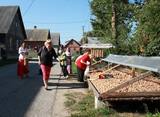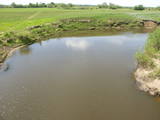| Nr | Name | Beschreibung |
|---|---|---|
|
Harilaidas galā no jūras ūdens paceļas 26 m augstā Kīpsāres bāka – viena no neparastākajām Igaunijas bākām. Tā celta 1933. g., kad jūra no bākas atradās ~ 100 m attālumā. Krastu noskalošanas rezultātā tā tagad ir viļņu ieskauta. |
||
|
Ziemeļos no Viļāniem (Jaunviļānos) atrodas ar mežu apaudzis osveidīgs paugurs – t.s. Kaupra kalns, kurā virsotnē meklējams (ceļa uz Trūpiem malā izvietota norāde) minētais akmens. Trīsdaļīgā akmens, kas atrodas mežā, garums ir 4 m, platums 3 m, augstums 1,9 m. Lielākās daļas virspusē var saskatīt nelielu dobumu, tādēļ pastāv viedoklis, ka šis ir sens kultakmens. |
||
|
"Valgums" is a word referring to the sandy coastline zone between dunes and water, and once there were boats and nets that were being dried at this location. Each village had several areas of this type, and in the 1920s and 1930s, these were of great importance in the preservation of the Liv language. |
||
|
Das Restaurant bzw. der Burgerladen "Raganas Burgers" ist auf 100% lettische Rindfleischburger, ausgewählte Pizzen und natürliche Pommes Frites spezialisiert. |
||
|
Starp cilvēku un zirgu valda īpaša saikne, ne velti zirgs cilvēkam spēj būt gan draugs, gan palīgs, gan sabiedrotais dažādās dzīves situācijās. Saimniecība “Imanti” piedāvā braucienus zirga kamanās ziemā un ratos – vasaras sezonā. |
||
|
Das Landgut, das der Familie der Barone Osten-Sacken gehört hat, wurde von 1856 – 1857 neu gebaut, weil das alte Landgut während des Krimkriegs (1853 – 1856) zerstört wurde. Es hat sich herausgestellt, dass am Anfang des erwähnten Kriegs englische Schiffe die lettische Küste und Schiffe beschossen haben, um den russischen Zaren Angst einzujagen. Dabei wurde auch Kolka beschossen, die damals zum Russischen Reich gehörte. Nach der Zerstörung des Landgutes wurde an ihrer Stelle das sogenannte Weiße Haus mit Wirtschaftgebäuden gebaut. Im ersten Geschoss des Hauses wurde ein Mantelschornstein für das Räuchern von Wild (hat sich bis heute erhalten) gebaut. Im Besitz der Adligen befand sich das Landgut bis zum Jahr 1919, als sein letzter Besitzer Christian von der Osten-Sacken in Tukums erschossen wurde. Im Jahr 1929 wurde in dem Weißen Haus eine Elementarschule eingerichtet, die künftig die Schule von Kolka genannt wurde und die bis 1961 (dann wurde eine neue Schule gebaut) arbeitete, aber bis 1989 fanden in dem Gebäude Werkunterrichte statt. Damals wird die Schule die Alte oder die Kleine Schule genannt. Seit 1991 gehört die Alte Schule von Kolka der Fakultät für Biologie der Universität Lettland und seit 1994 ist sie der Sommerpraktikumsort für Studenten. |
||
|
Am Ufer von Peipussee befinden sich dicht nacheinander Dörfer, die vor Jahrhunderte von den Altgläubigen, die aus Russland entflohen haben, bewohnt wurden - Kolkja, Kasepää und Varnja. |
||
|
A panoramic tour of Lithuania and Latvia with highlights of nature experiences in the National parks and nature reserves. A variety of landscapes, nature attraction sites, birds and wild animals, forests and seashore. The tour also offers some cultural and historical insights. Baltic States are lucky to have plenty of untouched natural territories. During the Cambrian, Silurian and Devonian eras, the territory of the current Baltic States was often covered by seawater, which is why there are places where lots of geological evidence can be found about these periods in history. These are manifested not just in fossils and various geological objects, but also in the unique landscape. For example, The Gauja River basin is an outstanding locations for Devonian cliffs and caves. Other interesting elements of the terrain relate to the development of the Baltic Sea in the past – the Baltic Ice Sea and the Littorine Sea. That is well presented at he landscape of hillocks and valleys in the Slītere National Park. Many forests and bogs have remained virtually untouched as biotopes here. The Ķemeri, Slītere national parks were all established to protect wetlands. Rivers in the Baltic States have not been straightened and dense areas of buildings are not common. There are two “lands of lakes” in the Baltic States – Latgale and Augštaitija. The Baltic States are at the crossroads of the living areas of many different plants and animals, and that is why “northern,” “southern,” “western” and “eastern” species can all be found here. Some national parks have been established to protect distinctive local cultural heritage. |
||
|
Duke Jacob of the Duchy of Kurzeme and Zemgale was on the throne from 1642 until 1862, and during that time the duchy rapidly expanded ship building operations, opened the first factories and improved agricultural output. Jacob's ships plied the seas to export goods, to establish colonies in Tobago and Gambia, and to bring sugar, coffee and spices back to Europe. This was the age when potatoes first appeared in Latvia, though it took a couple of centuries for them become beloved. |
||
|
Meklējams Virgas centrā. Asprātīgā piemiņas zīme (tēlnieks R. Gabaliņš, mākslinieks R. Kalniņš) – zābaks ar diviem pretēji vērstiem lielgabaliem un lodēm vēsta par Ziemeļu kara laika notikumiem, kad 1701. g. Virgā bija izveidota zviedru karaspēka nometne. Stāsta, ka karalis Kārlis XII savu zābaku pazaudējis citā reizē un vietā - Spilves kaujā pie Rīgas. |
||
|
Teritorijas apskates nolūkos ir izveidota un labiekārtota dabas izziņas taka. Dabas liegums atrodas Abavas senlejas dabas parka teritorijā. Taka iepazīstina ar vienīgo krūmu čužas savvaļas augšanas vietu Latvijā. |
||
|
The spoon workshop offers useful objects such as wooden spoons, cutting boards, butter knives, pans, spatulas, etc. You can produce your own wooden spoon and look at finished spoons made of more than 17 different types of wood from Latvia. During the summer the owners offer “pancake tours” with tasty jams. You can purchase spoons and homemade wine. |
||
|
Ein mit Wäldern bedecktes Gebiet, durch welches der Fluss Gauja fließt. Alte Flussärme, parkartige Eichenwiesen, Laubwälder und Schutzarte. Naturpfade. |
||
|
The Velēna Lutheran Church is at the crossing of the Smiltene-Gulbene-Lizums roads. It is said that the roof of the first wooden church at this location had a peat moss roof. The organ from the Sauer company still works, and it is one of the best organs in Latvia. The organist offers guided tours of the church. |
||
|
The Narūta River which flows out of Lake Ežezers is approximately 1 km long and ends at the small Obiteļi windmill lake. On the right bank of the river is a windmill that was built around 1900. Today the site has the Obiteļa leisure centre with a sauna and banquet facilities. |
||
|
This farm grows black currants, blackberries, raspberries, rowans, sea-buckthorn and other berries from which the owner produces homemade wine. The cellar of the castle of the former Order of Kuldīga (with room for up to 25 people) offers tastings of three different wines. Larger groups are welcome to the granary of the Padure Estate. |
||
|
Atrodas Cēsu rietumdaļā – pie ceļa, kas ved uz Cīrulīšiem. Piedāvājumā – plašs ēdienu klāsts no brokastīm līdz vakariņām. |
||
|
Dodieties ekskursijā, lai gūtu ieskatu lauku profesijā un dzīvesveidā, kā arī iegūtu jaunus iespaidus un labu atpūtu visai klasei. Ekskursijas laikā apciemojiet koka skulptūras Vienkoču parkā, kur iespējams iepazīties arī ar koka amatniecību un sameklēt dārgumu lādi. Vai arī apmeklējiet vienīgo vietu Baltijā, kur var iepazīties ar cilvēku dzīves apstākļiem pirms vairāk kā 1000 gadiem. Pēc tam apmeklējiet zemnieku saimniecību, kurā no cidonijām ražo sukādes, marmelādes, sīrupus un citus labumus, un pļavās ganās savvaļas zirgi. Ekskursijas noslēgumā dodieties uz Porcelāna fabriku, lai varētu padarboties apgleznošanas darbnīcā un iepazīties ar ražotni. |
||
|
SIA „Saldus Maiznieks" ist ein Familienunternehmen in der zweiten Generation, das seit 1992 ausgezeichnetes Roggenbrot und Feingebäck backt sowie geröstetes Knoblauchbrot produziert. Das Roggenbrot wird aus gebrühtem Mehl und Sauerteig zubereitet. Die Qualität der Arbeit wird von drei Bäckern überwacht, die als Mitglieder der lettischen Handwerkskammer zertifiziert sind. Produkte können im Laden der Bäckerei gekauft werden. |
||
|
Das ist ein wirklich einzigartiges Naturterritorium – das uralte Tal des Dviete-Flusses, die Seen Skuķi und Dviete und die Auenwiesen, die an das Flusstal angrenzen. Während der Überschwemmungszeit sind sie eine Art Sicherheitsventil für das Wasser der mächtigen Daugava. Die Wiesen können ein Grossteil des Flutwassers auffangen und später geben sie es langsam wieder an den Fluss zurück. All das erzeugt ein ziemlich ungewöhnliches Ökosystem. Das Flusstal ist wichtig für die Vögel während des Vogelzugs und zum Nisten. Im Jahre 2006 wurden Wildkühe in die Wiesen ausgewildert. Die touristische Infrastruktur muss in diesem Gebiet verbessert werden.
|
||





















